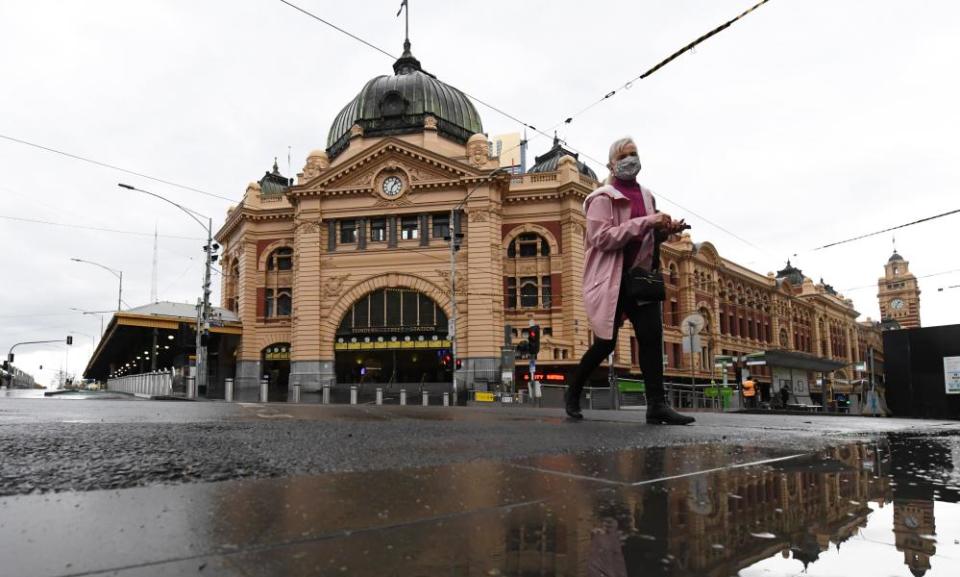Victoria's roadmap out of Covid lockdown is 'a sledgehammer approach', expert says

The Victorian government has “taken a sledgehammer approach” to its roadmap out of lockdown “when a hammer may have been just as effective”, Deakin’s chair of epidemiology Prof Catherine Bennett has said.
Bennett said it was important for the public to understand that the model, developed by computer scientists and epidemiologists from the University of Melbourne, assumed all cases of Covid-19 in the community were randomly distributed, and that all cases are mixing in the community in the same way. In reality, many cases are already in isolation, or are part of outbreaks in workplaces where transmission and movements may be different.
“Now, two-thirds of our cases are in health or aged care workers and their household contacts, and a third of cases are out in the community,” Bennett said. “So assuming we have 60 new cases per day by next weekend, that really means there would be roughly 20 community cases.”
Related: 'Still stand with Dan?': Victorian premier's career will live or die by his coronavirus gamble
The model assumed all 60 cases would be random cases in the community and did not account for unique settings like aged care, Bennett said. But if someone was Covid-19 positive, for most infected people, their movements would be anything but random, she said, and they would mostly stay indoors.
“This is not at all a criticism of the model or the modellers themselves, who have been very clear on what this model can and can’t do,” she said. But Bennett said she was unsure whether premier Daniel Andrews understood what epidemiology can offer, and that it is about more than just case numbers.
“Epidemiology is also the study of the determinants of the disease, or the risk, and involves investigating how disease spreads. Those two things used together prevent further cases. They see where virus is through testing and they know where cases are linked, but epidemiology is about also asking: ‘What’s different about these people getting sick when compared to another similar group?’”
The model was therefore setup to examine stage four and lockdown only, rather than what the effect might be if, for example, Victoria went back to stage three with mandatory masks. Or what might happen if curfew was dropped, but other measures kept in place.
“We can learn more about our epidemiology and out intervention effectiveness by investigating this spread from the inside,” she said. “This might give them confidence to navigate through different scenarios. So they are using a sledgehammer on a nut, only because they actually don’t know how small the hammer can be to crack that nut.”
Related: Melburnians react to 'very careful' roadmap out of Covid lockdown
This was problematic because the efficacy of each stage also required compliance, she said. Stage three with mass-compliance would be more effective than stage four with less compliance, she said.
“People want it explained: what does curfew add? If the chief health officer [Prof Brett Sutton] can show that they have less cases associated with people socialising against the rules now, and can show by how much, people would understand it.
“However, just last week the government revealed there were cases linked to a cluster socialising against the rules. That made me think: ‘does curfew work?’ If he could say we only had one illegal gathering this week and before curfew we used to have 10 a day, you could then put that in the models to properly evaluate the various we steps and measures. We don’t seem to be properly evaluating what the various steps contribute in terms of risk.”
In August, World Health Organisation technical lead Dr Maria Van Kerkhove said blanket lockdowns were a “blunt, sheer force instrument” and not the preferred response to Covid-19 outbreaks.
“Lockdowns are not something that WHO recommended, but they needed to be used in a number of countries because the outbreaks were growing so quickly,” Van Kerkhove told The Telegraph. “But we’re hopeful that countries will not need to implement national lockdowns again.” She said countries should consider “tailored, specific, localised” approaches.
The University of Melbourne team who developed the model explained it was a tool to help the government develop the roadmap, but it did not tell the government when or how to lift certain restrictions. The authors, writing in the university publication Pursuit, also said that it could not replace expertise “on the ground”.
Lead author of the piece, Dr Jason Thompson, is a computational social scientist and told Guardian Australia he could make no comment on how the model had been used by the government to inform its decisions.
“We are happy with the way in which the model works and the way it is constructed does help the government to think through different possibilities,” he said. “But we don’t control those possibilities. We also did all this work for free and we are seriously working 18 to 20 hours a day to check on model runs and trying to do the best we can to provide as much information as possible to help Victorians and also Australia.”
He said the model did not drill into aged care or hospitals to examine infection spread , and was never intended to. Thompson added the model was more sophisticated than other standard epidemiological models used to date.
“If someone said to us that it’s really important that we understand aged care in this model, we would have built a different one,” Thompson said. “But our model is clever in that it can automatically turn triggers on and off. But it’s not as clever as a Brett Sutton at the local level, who would know more about what’s going on in a particular setting. It’s a population-level model.”
The prime minister, Scott Morrison, said on Tuesday that the federal government has requested the detailed modelling from Victorian health authorities.

 Yahoo Finance
Yahoo Finance 